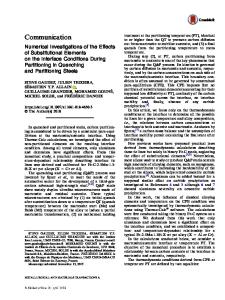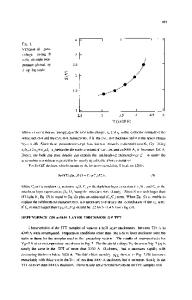The Effects of Post-Oxidation Anneal Conditions on Interface State Density Near the Conduction Band Edge and Inversion C
- PDF / 85,235 Bytes
- 7 Pages / 612 x 792 pts (letter) Page_size
- 8 Downloads / 275 Views
The Effects of Post-Oxidation Anneal Conditions on Interface State Density Near the Conduction Band Edge and Inversion Channel Mobility for SiC MOSFETs G.Y. Chung, C.C. Tin and J. R. Williams Physics Department, Auburn University, AL 36849 K. McDonald, M. Di Ventra, S.T. Pantelides a) and L.C. Feldman a) Department of Physics and Astronomy, Vanderbilt University, Nashville, TN 37235 a) Also at Oak Ridge National Laboratory, Oak Ridge TN 37831 R.A. Weller Department of Electrical Engineering and Computer Science, Vanderbilt University, Nashville, TN 37235 ABSTRACT Results are reported for the passivation of interface states near the conduction band edge in n-4H-SiC using post-oxidation anneals in nitric oxide, ammonia and forming gas (N2/5%H2). Anneals in nitric oxide and ammonia reduce the interface state density significantly, while forming gas anneals are largely ineffective. Results suggest that interface states in SiO2/SiC and SiO2/Si have different origins, and a model is described for interface state passivation by nitrogen in the SiO2/SiC system. The inversion channel mobility of 4H-SiC MOSFETs increases with the NO annealing. INTRODUCTION Silicon carbide (SiC) is a wide band gap semiconductor that has many properties that make it well suited for electronics applications under extreme conditions such as high temperature, high power, high frequency and high radiation [1]. One particular advantage is that SiC is the only member of the wide band gap family (SiC, the group III-nitrides and diamond) that has a native oxide. Silicon carbide can be thermally oxidized to form a device quality silicon dioxide dielectric layer [2]. For device fabrication, the 4H and 6H polytypes of SiC are currently available, and metal - oxide - semiconductor field effect transistors (MOSFETs) have been demonstrated for both polytypes. However, inversion channel mobilities are very low for 4H MOSFETs compared to 6H devices (~ 50 - 100cm2V-1s-1 compared to 10 cm2V-1s-1). This is an unexpected result, since 4H-SiC has higher bulk carrier mobilities than 6H-SiC [3]. Schorner, et al. [4] attribute the lower 4H inversion channel mobility to the presence of a high, broad density of interface states fixed in both polytypes at approximately 2.9eV above the valence band edge. We have measured the distribution of interface states across the SiC band gap using capacitance - voltage techniques to characterize MOS capacitors fabricated with both p- and n-4H-SiC (Fig.1). The states in the upper half of the band gap described by Schorner, et al. cause the distribution of states across the band gap to be asymetric. The majority of these states lie in the conduction band for 6H-SiC (Eg ~ 3eV) and have little effect carrier mobility in the inversion layer. However, a substantial fraction of these states may lie within the band gap for 4H-SiC (Eg ~ 3.3eV), so that in inversion, channel mobility is substantially reduced by field
T8.7.1
Dit (cm-2 eV-1)
1014
Figure 1. Interface state density in the band gap of 4H-SiC.
1013
n-4H n-4H (reox) p-4H p-4H
Data Loading...







